CHAPTER 7 Selected āsanas for integrating the aims and principles
Introduction
As we saw in Chapter 1, a dedicated practice of āsanas can include all other stages of yoga, such as yama, niyama, āsana, prā āyāma, pratyāhāra, dhāra
āyāma, pratyāhāra, dhāra ā, dhyāna, and samādhi. The ultimate aim of yoga is the union of the human with the divine, the individual soul with the universal soul. Health is a byproduct of practice, and a very important one (Iyengar 2002a). As described in Chapter 1, pratyāhāra, the fifth stage of the eightfold yoga path, is essential to prepare for the depth of practice of the āsanas. To achieve the inner movements during āsana practice, distractions of the senses, the organs of perception, must lessen and finally stop. The concentration and calmness needed to achieve this can be learned through breathing and listening (see Chapter 2) or the experience of subtle breathing (see Chapter 5). B K S Iyengar recommends cognitive action (Iyengar 2002a). This means that, while you are performing an āsana, the organs of perception – the eyes, ears, nose, tongue, and skin– are feeling what is happening in the body. This refined awareness must be integrated with willpower, intellectual and mental effort to move into the āsanas and to perform the instructions. When acting and awareness merge together the precision of the performance of the āsanas can be refined further: all layers of the body are penetrated, and body, mind, and soul become one. Learning the āsanas is a long and sometimes difficult process. There is a balance of activity and passivity, of strength and relaxation. Even if the body is fully stretched, there is relaxation at the same time.
ā, dhyāna, and samādhi. The ultimate aim of yoga is the union of the human with the divine, the individual soul with the universal soul. Health is a byproduct of practice, and a very important one (Iyengar 2002a). As described in Chapter 1, pratyāhāra, the fifth stage of the eightfold yoga path, is essential to prepare for the depth of practice of the āsanas. To achieve the inner movements during āsana practice, distractions of the senses, the organs of perception, must lessen and finally stop. The concentration and calmness needed to achieve this can be learned through breathing and listening (see Chapter 2) or the experience of subtle breathing (see Chapter 5). B K S Iyengar recommends cognitive action (Iyengar 2002a). This means that, while you are performing an āsana, the organs of perception – the eyes, ears, nose, tongue, and skin– are feeling what is happening in the body. This refined awareness must be integrated with willpower, intellectual and mental effort to move into the āsanas and to perform the instructions. When acting and awareness merge together the precision of the performance of the āsanas can be refined further: all layers of the body are penetrated, and body, mind, and soul become one. Learning the āsanas is a long and sometimes difficult process. There is a balance of activity and passivity, of strength and relaxation. Even if the body is fully stretched, there is relaxation at the same time.
With increasing practice hard work is transformed into inner strength, inner life, sensitivity. Each cell of the body is like an eye. What was effortful in the beginning becomes effortless (Iyengar 2005).
The description of each āsana has different sections:
 āsana and Pariv
āsana and Pariv tta Triko
tta Triko āsana, putting the hand on the floor creates a wrong basic alignment for many people, and so fine adjustments are not possible. First of all the lower hand should get enough support, for example on a brick, and then the alignment can be corrected precisely.
āsana, putting the hand on the floor creates a wrong basic alignment for many people, and so fine adjustments are not possible. First of all the lower hand should get enough support, for example on a brick, and then the alignment can be corrected precisely.While working in an āsana basic stability must be maintained; this relates to the calmness described above. In Yoga-Suātra II.46 it is described as follows: “sthira sukham āsanam – āsana is perfect firmness of body, steadiness of intelligence and benevolence of spirit” (Iyengar 2002b, p. 157). As an example of basic stability, we used the neutral lumbopelvic position extensively in Chapter 6. This position is important and helps to protect the spine in many lifting, bending, and twisting actions in the āsanas. Depending on the posture it needs to be adjusted differently. Where there is lumbar lordosis, it is important to tilt the pelvis backwards and lengthen the back of the pelvis. Where there is a flatter lower back it may be necessary to tilt forward. Both cases also need countermovements to achieve the optimal balance. For different āsanas different areas are relevant for this basic stability; for example, the feet, hips, shoulder blades, or cervical spine. There are no āsanas for isolated work on a special area, for example the pelvic floor, although the pelvic floor is strengthened through the correct performance of each āsana. As there are so many āsanas and variations, this work integrates the pelvic floor in many different ways.
At the end of this chapter, after all the āsana descriptions, hints will be given on how to combine basic exercises and āsanas and how to sequence āsanas. The basic exercises 1.4, 1.11, 1.13, 1.15, 3.2, 3.3, 3.4, 4.6, 4.11 and 8.5 (see Chapter 6) are preparations or easier versions of classical āsanas not explained in this book. For the full āsana, see Iyengar (2001) and Mehta et al (1990).
When learning the āsanas we strongly recommend that you work under the guidance of a qualified yoga teacher. Personal learning from a teacher is the traditional approach. The oldest yoga textbooks, the Upani ads, were first learned by heart from a personal teacher (see Chapter 1). This book is for your own additional practice. Regular practice in addition to learning from a teacher is essential to improve ability. To practice the āsanas with this book, a good method is to work in small groups. One person reads the instructions, while the other practices. If there are three of you, the third can observe. Interchanging the roles is a very good learning process.
ads, were first learned by heart from a personal teacher (see Chapter 1). This book is for your own additional practice. Regular practice in addition to learning from a teacher is essential to improve ability. To practice the āsanas with this book, a good method is to work in small groups. One person reads the instructions, while the other practices. If there are three of you, the third can observe. Interchanging the roles is a very good learning process.
Selected āsanas
1 Tā āsana (Figures 7.1 and 7.2)
āsana (Figures 7.1 and 7.2)
Being in the posture: basic work
Being in the posture: refined work
Suggestions for modifications using props
Variations
In summary, Tā āsana teaches many aims and principles which apply to all other āsanas.
āsana teaches many aims and principles which apply to all other āsanas.
2 V k
k āsana (Figure 7.3)
āsana (Figure 7.3)
Getting into the posture
Being in the posture: refined work
Finishing the posture
Stay in the posture for 5–10 breaths, then release according to one of the following methods:
 āsana.
āsana.Repeat “getting into the posture” and “being in the posture” for the left leg.
Suggestions for modifications using props
3 Utthita Triko āsana (Figure 7.5)
āsana (Figure 7.5)
Meaning of the āsana and its name
Utthita Triko āsana trains awareness of position in space; it particularly refines precision.
āsana trains awareness of position in space; it particularly refines precision.
Getting into the posture
Being in the posture: basic work
Being in the posture: refined work
Suggestions for modifications using props
4 V rabhadrāsana II (Figure 7.7)
rabhadrāsana II (Figure 7.7)
Getting into the posture
Being in the posture: basic work
Being in the posture: refined work
Suggestions for modifications using props
 rabhadrāsana I (see Figure 7.24). Repeat on the left side.
rabhadrāsana I (see Figure 7.24). Repeat on the left side.5 Utthita Pārśvako āsana (Figure 7.11)
āsana (Figure 7.11)
Getting into the posture
Being in the posture: basic work
Being in the posture: refined work
Suggestions for modifications using props
 āsana (see Figure 7.6) you can put the ball of the foot and the toes on a brick or rolled mat, and the lower hand on a support such as a brick or chair.
āsana (see Figure 7.6) you can put the ball of the foot and the toes on a brick or rolled mat, and the lower hand on a support such as a brick or chair.6 Ardha Candrāsana (Figure 7.13)
Getting into the posture
Being in the posture: basic work
Being in the posture: refined work
7 Par ghāsana (Figure 7.18)
ghāsana (Figure 7.18)
Getting into the posture
Being in the posture: basic work
Being in the posture: refined work
Finishing the posture
Stay in the posture for 5–10 breaths. Move your right foot off the brick into dorsiflexion, pull your right kneecap and thigh upwards, inhale, bring your trunk upright (Figure 7.17). Bend your right knee and kneel on both knees. Repeat on the left side.
Suggestions for modifications using props
8 Pārśvottānāsana (Figures 7.20 and 7.21)
Getting into the posture
Being in the posture: basic work
Being in the posture: refined work
Suggestions for modifications using props
9 V rabhadrāsana I (Figure 7.23)
rabhadrāsana I (Figure 7.23)
Getting into the posture
Being in the posture: basic work
Being in the posture: refined work
Finishing the posture
Hold the posture for 2–3 breaths in the beginning; increase to 5–10 breaths with practice.
Suggestions for modifications using props
10 V rabhadrāsana III (Figure 7.25)
rabhadrāsana III (Figure 7.25)
Getting into the posture
Being in the posture: refined work
Stay updated, free articles. Join our Telegram channel

Full access? Get Clinical Tree


 āsana is the mountain pose; it means being firm like a mountain, standing upright, concentrated, and still. You grow taller as a result of being firmly grounded. Tā
āsana is the mountain pose; it means being firm like a mountain, standing upright, concentrated, and still. You grow taller as a result of being firmly grounded. Tā āsana is one of the simplest and at the same time the most complex āsanas. It develops a good habit of standing; activity and calmness merge together.
āsana is one of the simplest and at the same time the most complex āsanas. It develops a good habit of standing; activity and calmness merge together.

 k
k a means tree in Sanskrit. In all cultures, religions, and many fairy tales, the tree is a symbol of life. V
a means tree in Sanskrit. In all cultures, religions, and many fairy tales, the tree is a symbol of life. V k
k āsana particularly teaches you to find your balance and stay concentrated even if you are moved around, and to combine stability and flexibility in growing from solid roots.
āsana particularly teaches you to find your balance and stay concentrated even if you are moved around, and to combine stability and flexibility in growing from solid roots.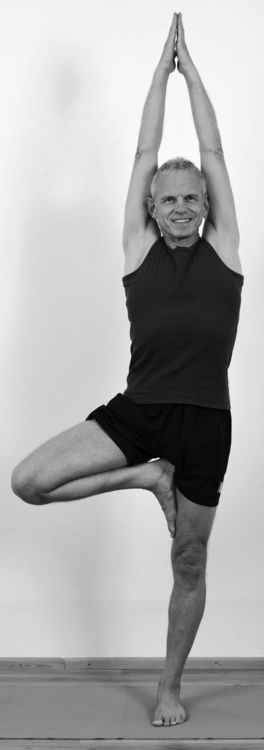
 āsana.
āsana. āsana.
āsana.
 a means triangle. The number 3 and the triangle are fundamental in nature and in many philosophical and religious systems to describe the secret of life.
a means triangle. The number 3 and the triangle are fundamental in nature and in many philosophical and religious systems to describe the secret of life.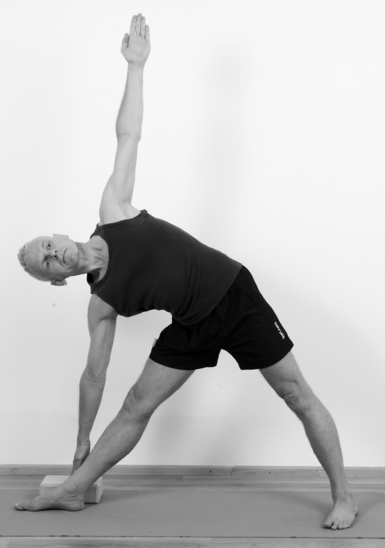
 āsana.
āsana. āsana; stay calm for a few breaths.
āsana; stay calm for a few breaths.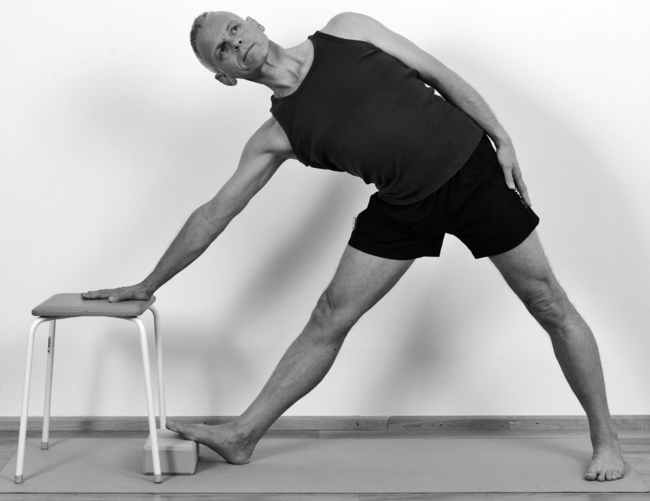
 rabhadra was a powerful hero in ancient Indian mythology. This āsana is the second of a series of three āsanas dedicated to him (V
rabhadra was a powerful hero in ancient Indian mythology. This āsana is the second of a series of three āsanas dedicated to him (V rabhadrāsana I, II, and III). It is performed with strength and at the same time is relaxed.
rabhadrāsana I, II, and III). It is performed with strength and at the same time is relaxed.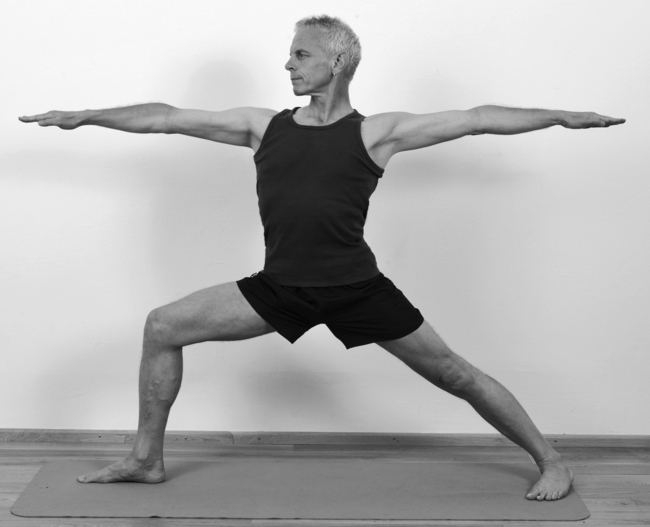
 āsana.
āsana.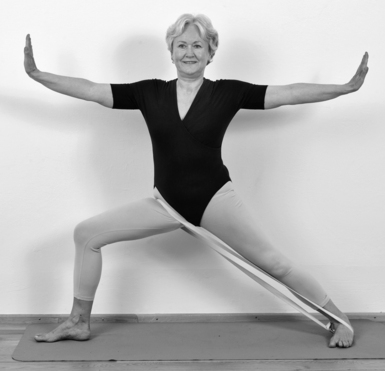
 āsana, and stay calm for a few breaths.
āsana, and stay calm for a few breaths.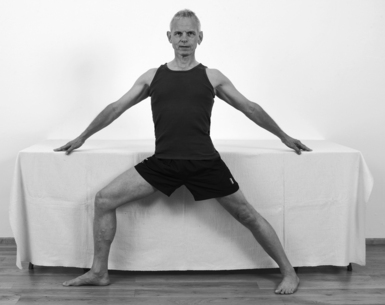
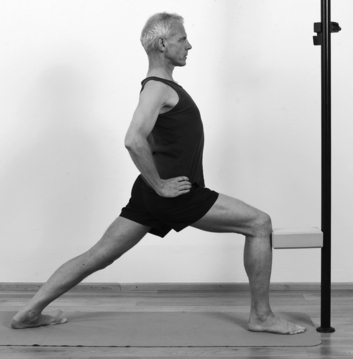

 a means angle. In Utthita Pārśvako
a means angle. In Utthita Pārśvako āsana one leg is bent at a right angle, the trunk is stretched over it to the side; the straight leg, the upper side of the trunk, and the upper arm are in one line. There is an intensive stretch from the toes to the fingertips. Precise alignment, particularly from the deep structures of the body, is vital for this āsana.
āsana one leg is bent at a right angle, the trunk is stretched over it to the side; the straight leg, the upper side of the trunk, and the upper arm are in one line. There is an intensive stretch from the toes to the fingertips. Precise alignment, particularly from the deep structures of the body, is vital for this āsana.
 āsana.
āsana. rabhadrāsana II for a moment.
rabhadrāsana II for a moment. āsana and stay calm for a few breaths.
āsana and stay calm for a few breaths.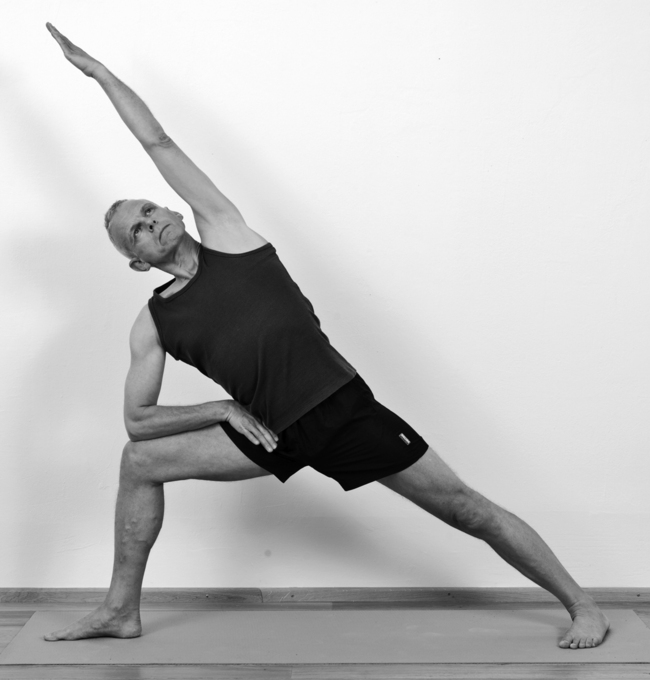
 āsana to Ardha Candrāsana are reminiscent of different shapes of the moon. Practicing this is good training in staying stable and calm during changes. Ardha Candrāsana develops stability during moving, and harmony between what we feel and what we are doing. It teaches coordination and synchronization between the actions of the legs and arms.
āsana to Ardha Candrāsana are reminiscent of different shapes of the moon. Practicing this is good training in staying stable and calm during changes. Ardha Candrāsana develops stability during moving, and harmony between what we feel and what we are doing. It teaches coordination and synchronization between the actions of the legs and arms. āsana.
āsana. āsana to the right.
āsana to the right. āsana, and then to a standing position with the legs apart and the feet parallel. Repeat on the other side. After finishing both sides stay calmly in Tā
āsana, and then to a standing position with the legs apart and the feet parallel. Repeat on the other side. After finishing both sides stay calmly in Tā āsana for a few breaths.
āsana for a few breaths.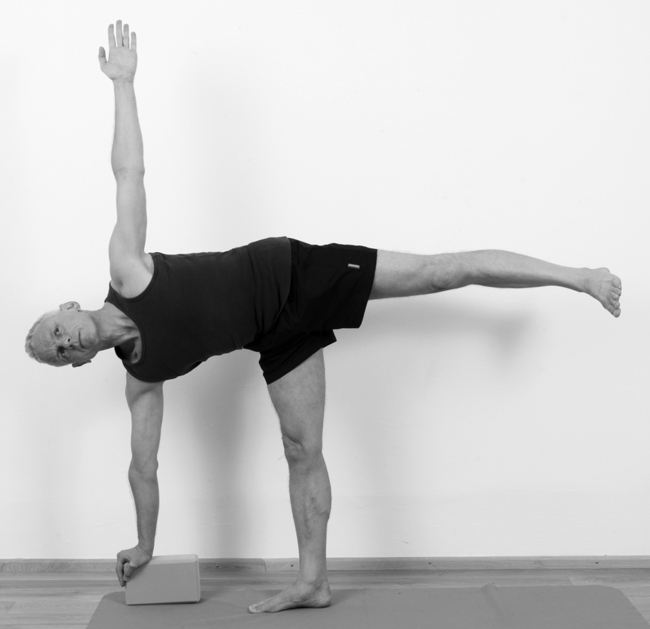
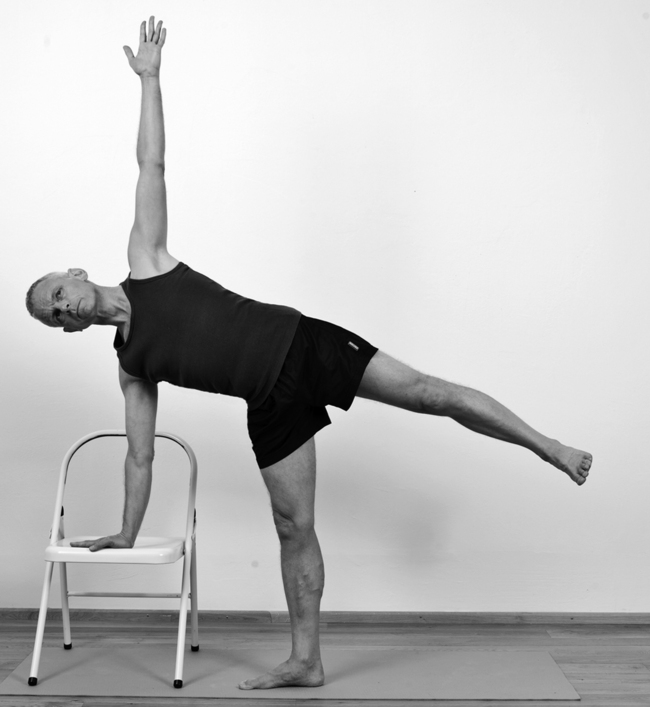
 rgha is an oblique beam closing a gate. This posture resembles a gate with an oblique beam. The straight leg is the beam, the trunk is an arch, the top of the gate, and the core of the arch is the spine in side-bending.
rgha is an oblique beam closing a gate. This posture resembles a gate with an oblique beam. The straight leg is the beam, the trunk is an arch, the top of the gate, and the core of the arch is the spine in side-bending.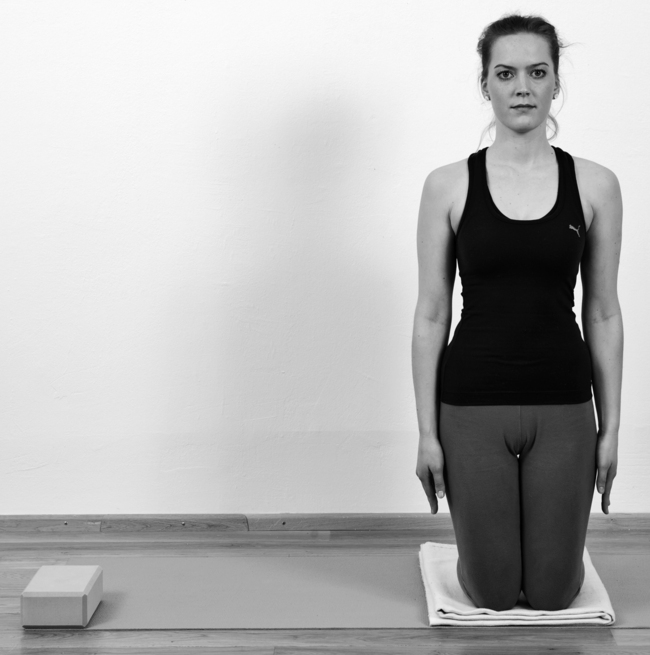
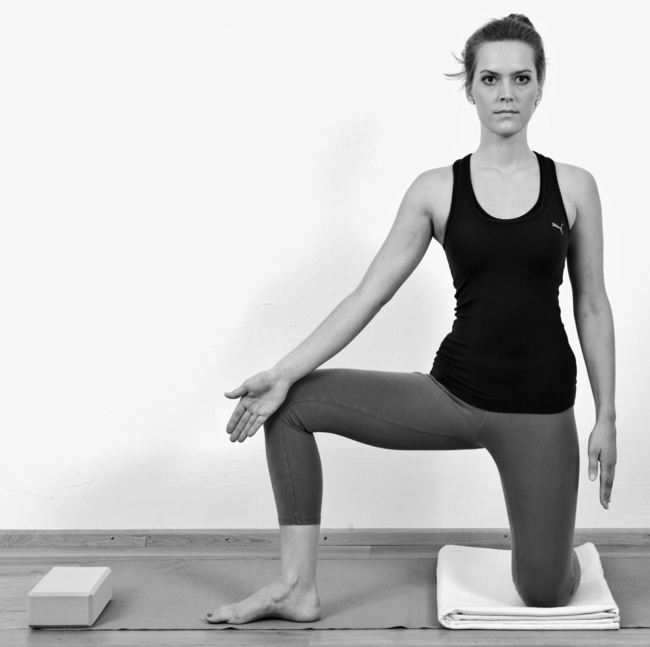
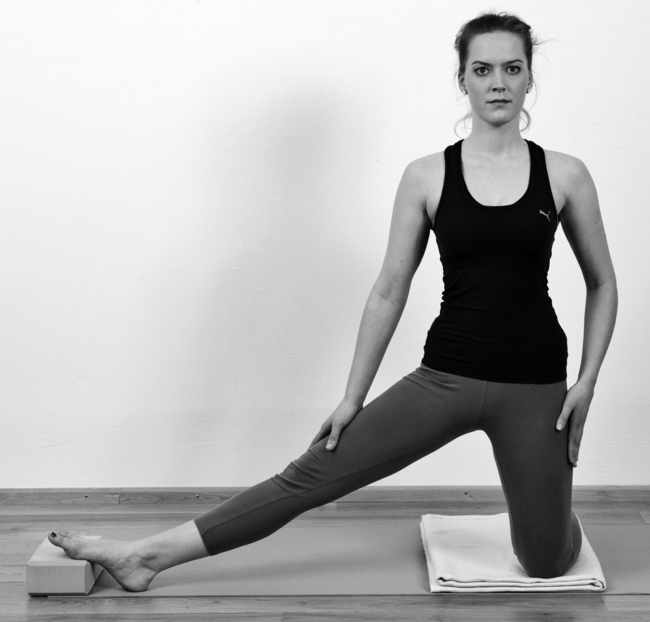
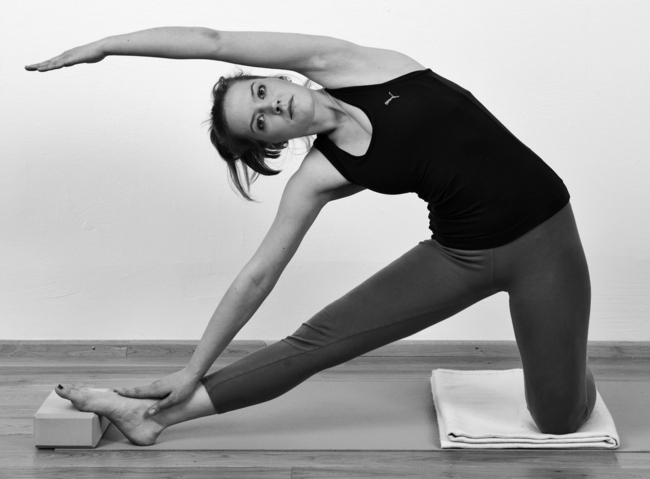

 āsana.
āsana.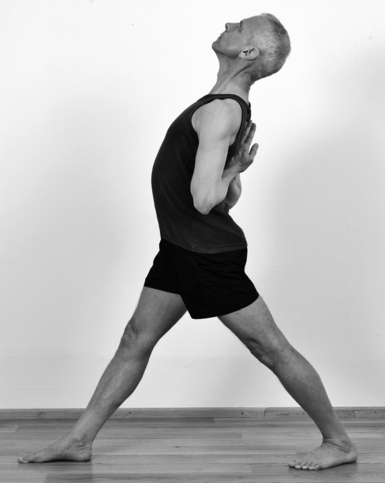

 āsana, and stay calm for a few breaths.
āsana, and stay calm for a few breaths.
 rabhadrāsana I is the first of the three āsanas dedicated to the powerful hero V
rabhadrāsana I is the first of the three āsanas dedicated to the powerful hero V rabhadra of ancient Indian mythology. It is performed with strength while at the same time being relaxed.
rabhadra of ancient Indian mythology. It is performed with strength while at the same time being relaxed.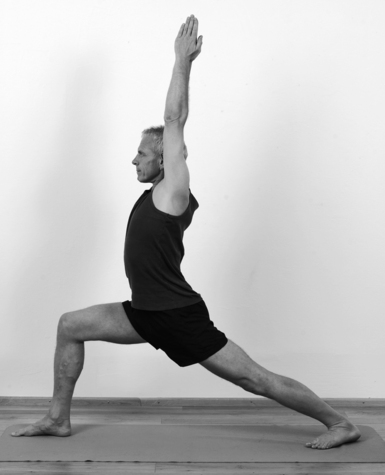
 āsana.
āsana. āsana, and stay calm for a few breaths.
āsana, and stay calm for a few breaths. rabhadrāsana III is the third of the three āsanas dedicated to the powerful hero V
rabhadrāsana III is the third of the three āsanas dedicated to the powerful hero V rabhadra of ancient Indian mythology. It is performed with strength while at the same time being centered and relaxed. V
rabhadra of ancient Indian mythology. It is performed with strength while at the same time being centered and relaxed. V rabhadrāsana III develops strength and balance while moving. It teaches coordination and the synchronization of movements and calms the mind.
rabhadrāsana III develops strength and balance while moving. It teaches coordination and the synchronization of movements and calms the mind.
 āsana.
āsana. rabhadrāsana I to the right.
rabhadrāsana I to the right. rabhadrāsana I, straighten the right leg, and turn to the center. Relax your arms if necessary. Repeat on the left side. After finishing both sides come back to Tā
rabhadrāsana I, straighten the right leg, and turn to the center. Relax your arms if necessary. Repeat on the left side. After finishing both sides come back to Tā āsana; stay there calmly for a few breaths.
āsana; stay there calmly for a few breaths.
